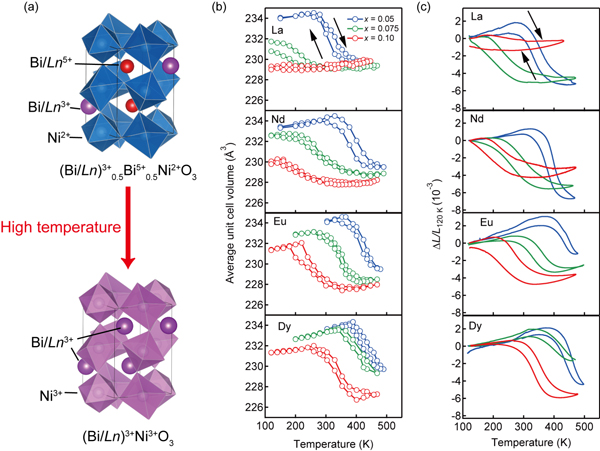Tokyo Tech News
Tokyo Tech News
Published: February 7, 2014
Negative thermal expansion (NTE) material, in which the volume contracts on heating, have attracted much attention because these can suppress the thermal expansion in structure materials.
Nanoscale manufacture of electronic devices and optical communications requires precise positioning, and thus, even small amounts of thermal expansion can be a problem.
Now, Kengo Oka, Masaki Azuma and colleagues at Tokyo Institute of Technology and Kyoto University have shown that Bi1-xLnxNiO3 (Ln = La, Nd, Eu, Dy) exhibit NTE large enough to compensate the thermal expansion of plastics in the controlled temperature range around room temperature.
Bi1-xLnxNiO3 (Ln = La, Nd, Eu, Dy) were prepared by high-pressure synthesis at 6 GPa and 1000 ℃. The NTE properties were investigated by powder X-ray diffraction (XRD) study and the dilatometric measurement using a thermal mechanical analysis (TMA) method.
There was a large NTE over αL = 70 ppm/K for Bi0.95Ln0.05NiO3 (Ln = La, Nd, Eu, Dy). The temperature range was 280-400 K for Bi0.95La0.05NiO3. The onset temperature was higher for Ln3+ with a smaller radius, and decreased with increasing x value.
Since Bi1-xLnxNiO3 has a tunable NTE, it is a promising material for compensating positive thermal expansion of structure materials over the desired temperature range.

(a) Temperature induced charge transfer transition in Bi1-xLnxNiO3
(b) Temperature dependences of average unit cell volume estimated by XRD study.
(c) Dilatometric liner thermal expansions measured by TMA method.
Authors: |
Kengo Oka, Koichiro Nabetani, Chika Sakaguchi, Hayato Seki, Michal Czapski, Yuichi Shimakawa, and Masaki Azuma |
Title of original paper: |
Tuning negative thermal expansion in Bi1-xLnxNiO3 (Ln = La, Nd, Eu, Dy). |
Journal, volume, pages and year: |
Applied Physics Letters 103, 061909 (2013) |
Digital Object Identifier (DOI): |
|
Affiliations: |
Materials and Structures Laboratory, Tokyo Institute of Technology, and Institute for Chemical Research, Kyoto University |
Department website: |